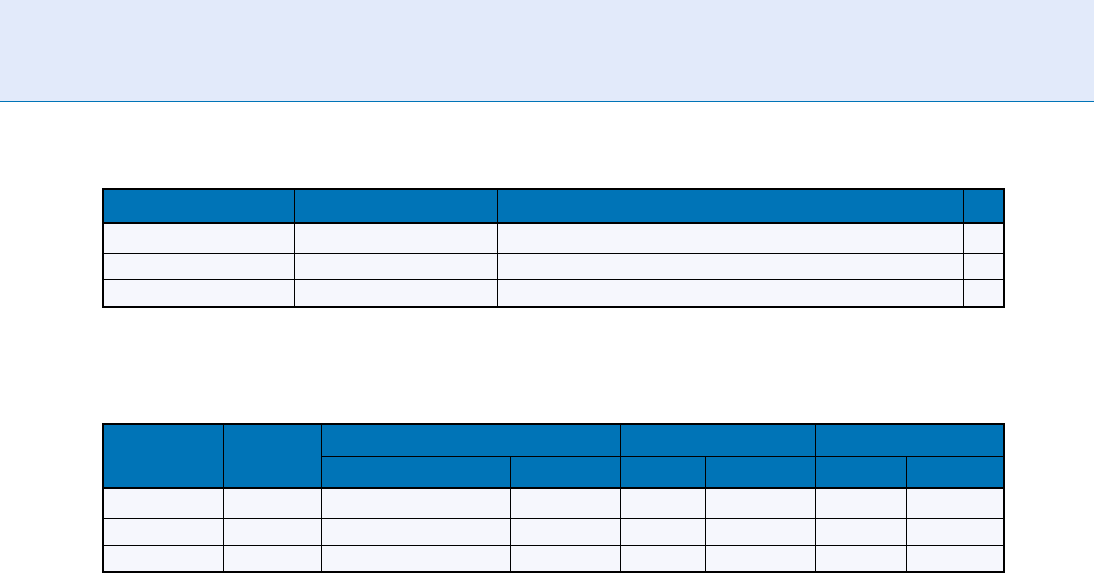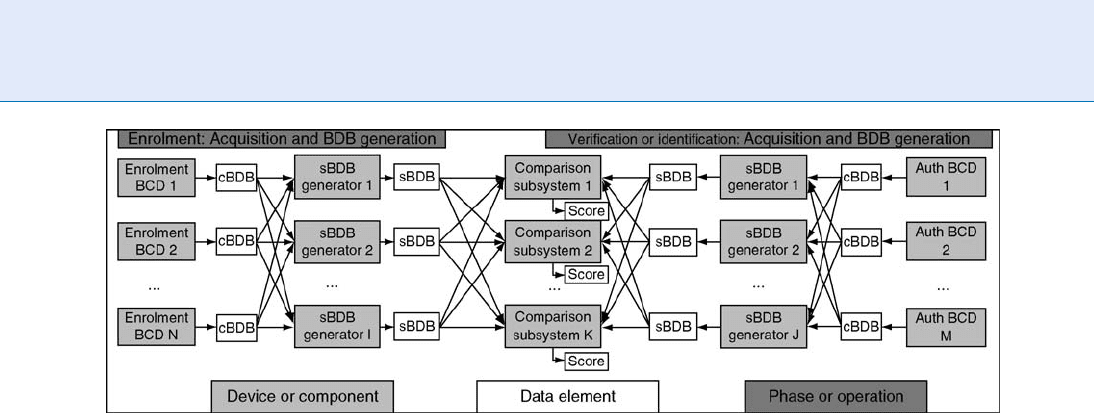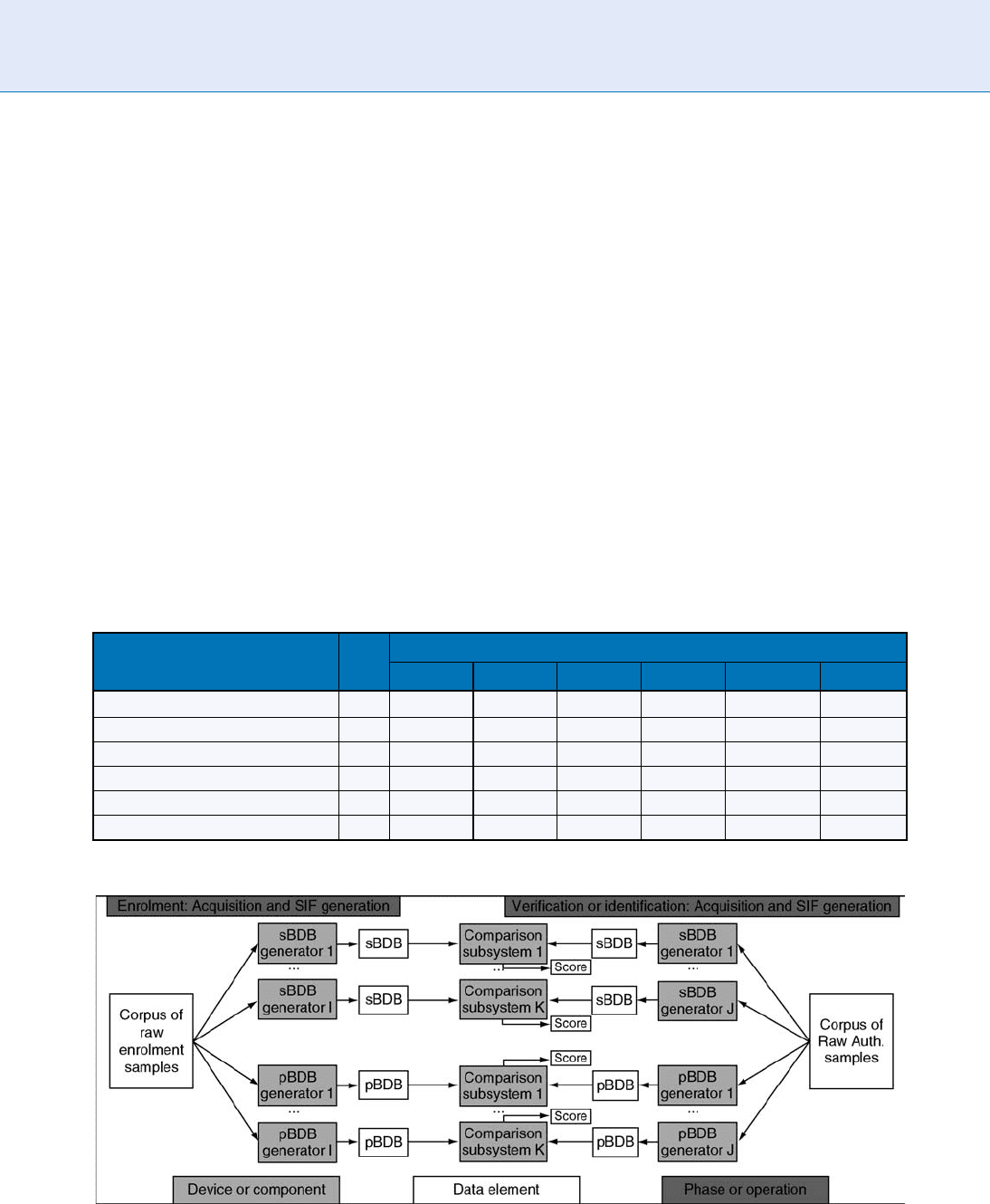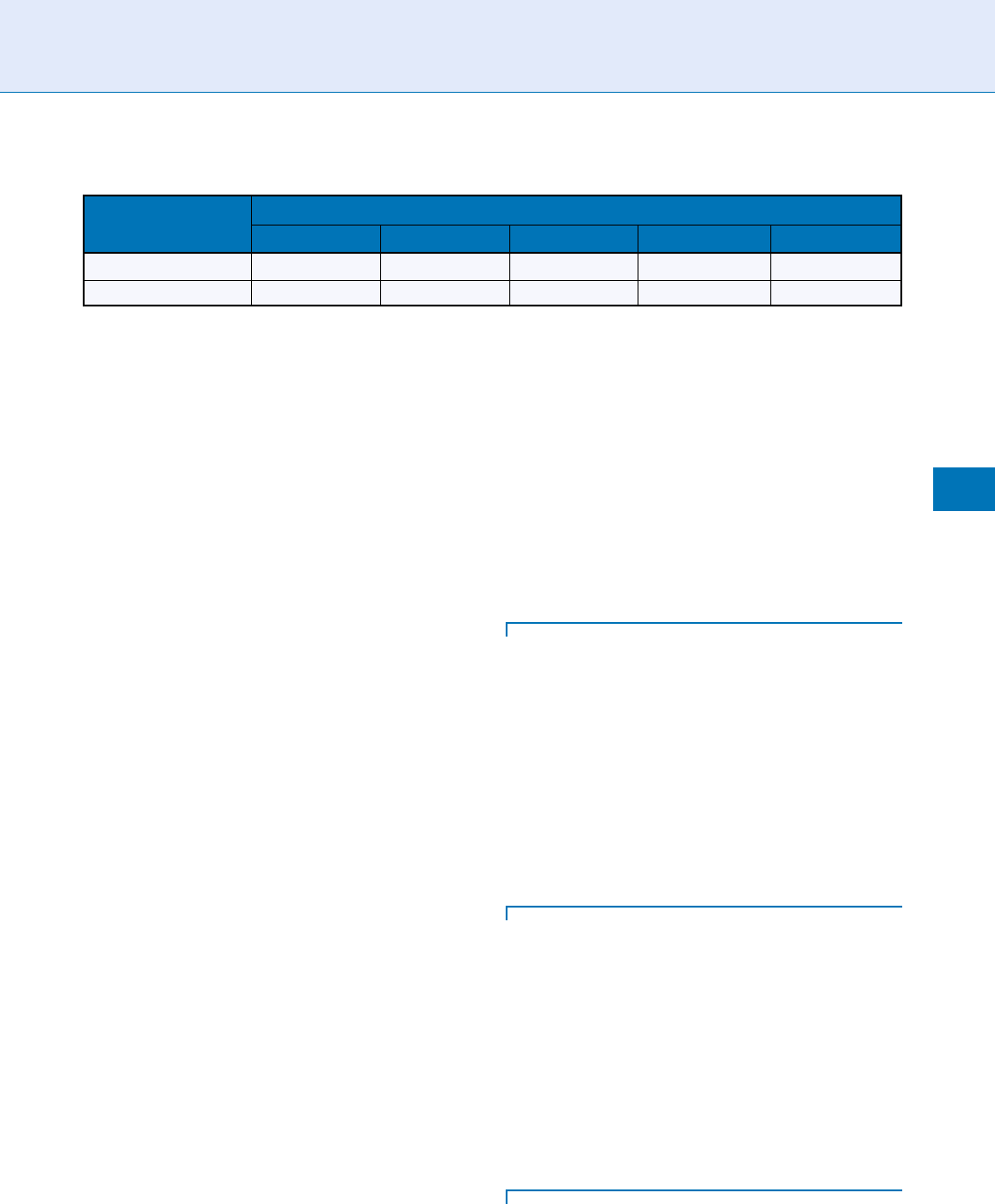Li S.Z., Jain A.K. (eds.) Encyclopedia of Biometrics
Подождите немного. Документ загружается.


matcher dependent. Since fingerprint individuality is
assessed based on minutia e location and direction
only, the matcher of [10] was used which depends
only on minutiae information.
Note that as m or n or both increase, the values of
PRCs for both the models become large as it becomes
much easier to obtain spurious matches for larger m
and n values. Additionally, Table 3 illustrates an impor-
tant fact: The PRCs based on the mixture models are
orders of magnitude larger compared to Pankanti’s
model and closer to the empirical probability of at
least w matches. Note also that the mean of ls (the
theoretical mean number of matches) are closer to
the empirical counterpart (mean number of observed
matches) compared to Pankanti’s model. This demon-
strates the adequateness of the mixture models for
the assessment of fingerprint individualit y. While the
mixture models is more adequate at representing min-
utiae variability, the PRCs obtained are far too large
indicating a large amount of uncertainty in declaring a
match between a fingerprint pair. One way to reduce
the PRC is to add more fingerprint features when
performing the identification. Fingerprint individuali-
ty assessment can then be made by developing appro-
priate statistical models for these features.
Summary and Future Work
In this chapter, an overview of the challenges involved
in assessing the individualit y of fingerprints is
presented. Two works have been discussed. Pankanti’s
model is the first attempt at modeling the observed
minutiae distribution via statistical models, whereas
Zhu et al. developed more flexible models that ade-
quately describe all minu tiae characteristics. There are
many open problems that still remain unsolved. Both
works have only addressed the issue of interclass min-
utiae variability. Appropriate statistical models for
modeling the intraclass minutiae variability are still
very few in the literature. A very important source of
intraclass variability is the quality of the query and
template images, and work still needs to be done to
investigate how PRCs change with quality of the fin-
gerprint image. It is also important to develop statisti-
cal models for more complex fingerprint features. In
this case, one can use more useful matching criteria
that utilize richer fingerprint features.
In this chapter, the PRCs have been related to the
false match rates. Another measure of fingerprint indi-
viduality should be related to the false nonmatch rates.
Eventually, a measure of fingerprint individuality should
be a optimal combination of the two measures of errors.
Acknowledgments
The authors like to thank Prof. Anil Jain for introduction
of the fingerprint individuality problem to them and
for many subsequent discussions that has helped them
in their research in this area. This chapter was written
under the support of the NSF DMS grant 0706385.
Individuality of Fingerprints. Table 3 A comparison between fingerprint individuality estimates using the (a) Poisson
and mixture models, and (b) Pankanti et al. [2]
Database (m,n,w)
Empirical Mixture Pankanti
Mean no. of matches PRC Mean l PRC Mean l PRC
NIST (52,52,12) 7.1 3.9 10
3
3.1 4.4 10
3
1.2 4.3 10
8
FVC2002 DB1 (51,51,12) 8.0 2.9 10
2
4.9 1.1 10
2
2.4 4.1 10
6
FVC2002 DB2 (63,63,12) 8.6 6.5 10
2
5.9 1.1 10
2
2.5 4.3 10
6
Individuality of Fingerprints. Table 2 Table giving the mean m and n in the overlapping area, the mean overlapping
area and the value of M for each database [7]
Database (m,n) Mean overlapping area (pixel
2
)
M
NIST (52,52) 112,840 413
FVC2002 DB1 (51,51) 71,000 259
FVC2002 DB2 (63,63) 110,470 405
750
I
Individuality of Fingerprints

Related Entries
▶ Fingerprint
▶ Fingerprint Individuality
▶ Fingerprint Matching, Automatic
▶ Fingerprint Matching, Manual
▶ Forensic Evidence of Individuality
References
1. Daubert v. Merrel Dow Pharmaceuticals Inc.: 509 U.S. 579,
113 S. Ct. 2786, 125, L.Ed.2d 469 (1993)
2. Pankanti, S., Prabhakar, S., Jain, A.K.: On the individuality of
fingerprints. IEEE Trans. Pattern Anal. Mach. Intell. 24(8),
1010–1025 (2002)
3. United States v. Byron Mitchell: Criminal Action No. 96-407,
United States District Court for the Eastern District of Pennsyl-
vania (1999)
4. United States Department of Justice: Document SL000386,
March 2000. Online: http://www.forensic-evidence.com/site/
ID/IDfpValidation.html
5. Scolve, S.C.: The occurence of fingerprint characteristics as a two
dimensional process. J. Am. Stat. Assoc. 74(367), 588–595
(1979)
6. Stoney, D.A., Thornton, J.I.: A critical analysis of quantitative
fingerprint individuality models. J. Forensic Sci. 31(4),
1187–1216 (1986)
7. Zhu, Y., Dass, S.C., Jain, A.K.: Statistical models for assessing the
individuality of fingerprints. IEEE Trans. Inf. Forensics Secur.
2(3), 391–401 (2007)
8. NIST: 8-bit gray scale images of fingerprint image groups
(FIGS). Online: http://www.nist.gov/srd/nistsd4.htm
9. Maio, D., Maltoni, D., Cappelli, R., Wayman, J.L., Jain, A.K.:
FVC2002: Fingerprint verification competition. In: Proceedings
of the International Conference on Pattern Recognition (ICPR),
pp. 744–747 (2002)
10. Ross, A., Dass, S., Jain, A.K.: A deformable model for fingerprint
matching. Pattern Recognit 38(1), 95–103 (2005)
Individualization
▶ Fingerprint Matching, Manual
Influencing Factors
▶ Influential Factors to Performance
Influential Factors to Performance
KAO RU UCHIDA
NEC Corporation, Kawasaki, Japan
Synonym
Influencing factors
Definition
Factors that influence biometric performance. They
can be discussed from the following viewpoints: char-
acteristics of users (including the definition of im-
postors) and restrictions that come from practical
situations in which that biometric modality is used in
applications.
Introduction
When evaluating performance of biometric systems,
factors that influence performance (‘‘influencing fac-
tors’’) should be identified and analyzed because per-
formance is greatly affected by a w ide variety of
influencing factors. The same biometric device may
generate different test results if these influencing factors
differ. Controlling, recording, and reporting factors are
indispensable for executing repeatable performance
tests and predicting operational performance [1–3].
Influencing Factors
Identifying influencing factors: the following factors
should be considered at a minimum (see also Annex
Cof[1]):
1. Biometric sensor quality and characteristics
2. Biological or behavioral characteristics of the sub-
ject relevant to data collection (essential historical
or demographic data):
a. Invariable: Gender, ethnic origin
b. Variable:
Biological: age, body dimensions/anthropo-
metric data (height, weight, etc...), muscu-
loskeletal disorders
Influential Factors to Performance
I
751
I

Habitual/Social factors: smoking preference,
hairstyle, makeup, eyewear (glasses, con-
tacts, etc...), clothing
Occupation
3. Environmental factors applicable to the biometric
device, sensor, or application such as:
a. Temperature
b. Humidity
c. Illumination
Type (standard incandescent, fluorescent,
tungsten halogen, reflector lamps, light
emitting diodes (LEDs), sunlight, etc...)
d. Noise
e. Position of sensor with regards to the user
4. Temporal change of the biometric features
5. Impact of
▶ forgery attempts on false acceptance,
particularly in behavioral modalities
6. Differences between the data capture and signal
processing subsystems used in the enrolment phase
and those used in the verification/identification
phase. (This text taken ISO/IEC TR 19795-3:2007
Information technology – Biometric performance
testing and reporting – Part 3: Modality-specific
testing is reproduced with the permission of the
International Organization for Standardization,
ISO. This standard can be obtained from any ISO
member and from the Web site of the ISO Central
Secretariat at the following address: www.iso.org.
Copyright remains with ISO).
In addition, the characteristics that affect performance
can be discussed from the following aspects:
1. The definition of impostors
2. Restrictions that come from practical situations in
which that biometric modality is used in applications
Characteristics of Impostors
There are two factors to consider the definition of
impostors:
1. Multiple biometric data from one person
2. Impostor attempts for behavior-based modalities,
such as voice or signature
For modalities in which multiple bio metric data can be
collected from one person, e.g., finger (10 fingerprints
from one person) and iris (2 iris-images from one
person), a rule for permitting or prohibiting the use
of these data as impostor attempts should be clearly
defined in performa nce testing.
In the case of behavior-based modalities, testing
results regarding impostor attempts (FMR or FAR)
may be influenced depending on whether (or how
much) an impostor tries to imitate an authorized
user’s behavior. For instance, the case in which an
impostor physically traces an authorized user’s signa-
ture that the impostor obtained differs significantly in
FMR or FAR from the case, where the imposto r only
looks at the signature and imitates it. For these
modalities, a criterion regarding impostor attempts
should be defined in performance testing.
Characteristics of Modality Specific to
Applications
In general, almost all modalities of biometrics are
used for user authentication, but some modalities are
expected to be used in different classes of applications,
for example, face-based identification is widely used in
surveillance applications. While a user’s cooperation
can be expecte d in the former, it cannot be expected in
the latter case. Thus, variation of performance testing
should be considered depending on the way the mo-
dality is used in real applications.
These restrictions can be divided into two
classifications:
1. Factors relating to users, such as facial expressions
that affect the countenance of the face, wearing
eye-glasses or contact lenses for the iris, etc.
2. Factors relating to external environments that are
uncontrollable by the algorithm or system, such as
illumination change for face or background noise
for voice
These factors naturally affect the performance, and the
types and number of factors are different in each mo-
dality. These modality-dependent variations should be
considered in performance testing. In addition, a con-
cept of
▶ robustness test should be introduced to eval-
uate the sensitivity or robustness of the technology
toward environmental factors, in case the variation
of the factors strongly influences the observed
performance.
752
I
Influential Factors to Performance

Related Entries
▶ Performance Evaluation, Overview
▶ Performance Measures
▶ Performance Testing Methodology, Standardization
References
1. ISO/IEC 19795-1:2006 Information technology – Biometric per-
formance testing and reporting – Part 1: Principles and
framework
2. ISO/IEC 19795-2:2007 Information technology – Biometric per-
formance testing and reporting – Part 2: Testing methodologies
for technology and scenario evaluation
3. ISO/IEC TR 19795-3:2007 Information technology – Biometric
performance testing and reporting – Part 3: Modality-specific
testing
Information Content of Iris Images
▶ Iris Image Quality
Information Fusion
Information fusion is the merging of disparate informa-
tion, usually from different sources, which is combined
in order to achieve a wider perspective on a problem
than is possible if only one type of information were
considered. In the context of multimodal biometric
authentication, the term is used to describe how infor-
mation from different biometric modalities, for exam-
ple a facial image and a voice sample, can be combined
to make a better decision on whether the person seek-
ing to be authenticated is who he or she claims to be.
Depending on where in the system the information
from the two modalities is combined, one can distin-
guish between feature fusion, score fusion, and decision
fusion. Feature fusion is also known as early fusion,
while the latter two fusion types are know n collectively
as late fusion. Feature fusion is a method, by which the
features from the different modalities are fused into
combined feature vectors after the feature extraction
stage, but before the pattern recognition stage of the
authentication system. The pattern recognition process
then proceeds on the basis of the combined feature
vectors. Score fusion is a method, by which a separate
authentication system for each modality calculates a
mathematical likelihood or distance score between the
feature and the client model or template in that mo-
dality. The score fusion algorithm then combines the
two modality scores by means of a suitable formula,
such as the arithmetic mean of the two scores, and the
final accept–reject decision is made on the basis of the
combined score. Decision fusion is a method, by which
each modality has its own independent authentication
process – from feature extrac tion throug h score calcu-
lation to final accept–reject decision for that modality.
The overall accept–reject decision by the system is then
made through a simple logical combination of the two
modality decisions. Two decision fusion paradigms are
possible in a bimodal system: a strict system requires
an ‘‘accept’’ from both modalities for an overall accept
decision, while a generous system only requires an
‘‘accept’’ from either modality for an overall accept
decision. A system, which is to detect synchrony be-
tween the audio and video signals from a speaking face,
requires early fusion, while late fusion is sometimes
used when two off-the-shelf commercial authentica-
tion systems are combined and the user has no access
to the internal feature vectors of the two systems.
▶ Liveness Assurance in Face Authentication
Intelligent Agents
Software (sub-)systems that may act autonomously on
behalf of users of the system.
▶ Biometric Systems, Agent-Based
Interaction
The result an individual, using a biometric sensor,
creates by presenting biometric characteristics to a
Interaction
I
753
I

sensor. In terms of the general biometric model, this
occurs in the data capture silo. During an individual’s
interaction, the biometric sensor or device acquires an
image or signal of biometric characteristics of a person.
The goal of the presentation is for an individual to
present the biometric characteristics of high quality to
the sensor in a repeatable and consistent manner, so
that the subsequent signal processing sub-processes of
segmentation, feature extraction, and quality control
can successfully occur. See also attempt, presentation,
transaction, and general biometric model.
▶ Ergonomic Design for Biometric Systems
Interactive Voice Response (IVR)
Interactive voice response (IVR) is an automated, ‘‘self
service’’ telephony technology that interacts with a
caller to gather and dispense information, perform
transactions, or route the call to the appropriate recip-
ient. IVR systems can accept touchtone (DTMF),
spoken (speech recognition) input, or a combination
of the two modalities.
▶ Remote Authentication
▶ Speaker Recognition, Standardization
Interest Point, Region, Local Feature
In a way, the ideal local feature is a point as defined in
geometry: having a location in space but no spatial
extent. In practice however, images are discrete with
the smallest spatial unit being a pixel and discretization
effects playing an important role. To localize features in
images, a local neighborhood of pixels need to be
analyzed, giving all local features some implicit spatial
extent. For some applications (e.g., camera calibration
or 3D reconstruction), this spatial extent is completely
ignored in further processing, and only the location
derived from the feature extraction process is used. In
those cases, one typically uses the term interest point.
However, in most applications those features also need
to be described, such that they can be identified and
matched, and this again calls for a local neighborhood
of pixels. Often, this neighborhood is taken equal to
the neighborhood used to localize the feature, but this
need not be the case. In this context, one typically uses
the term region instead of interest point. However,
beware: when a local neighborhood of pixels is used
to describe an interest point, the feature extraction
process has to determine not only the location of the
interest point, but also the size and possibly the shape
of this local neighborhood. Especially in case of geo-
metric deforma tions, this significantly complicates the
process, as the size and shape have to be determined in
an invariant (covariant) way.
▶ Local Image Features
Interest Points
▶ Local Image Features
Interface
▶ User Interface, System Design
Intermediate Biometrics
▶ Biometric Sample Synthesis
Internal Identification
Identification of a victim based on medical findings by
an autopsy, such as implan ts, and missing organs.
▶ Dental Biometrics
754
I
Interactive Voice Response (IVR)

International Association for
Identification
▶ Fingerprint, Forensic Evidence of
Interoperability
Interoperability in biometrics can be defined as the
capability of a recognition system to operate with
data from different sources (e.g., data acquired using
different sens ors or features extracted using systems
from different vendors). Most biometric systems are
designed und er the assumption that the data to be
compared with are obtained from a unique source
and are restricted in their ability to match or compare
with biometric data originated from different sources.
As a result, changing the source may affect the perfor-
mance of the system.
▶ Fingerprint Databases and Evaluation
▶ Iris Device
Interoperable Performance
PATRICK GROTH ER
National Institute of Standards and Technology,
MD, USA
Definition
Accuracy of a biometric system that includes standar-
dized components from several suppliers.
In applications where components conform to
standardized interfaces and functional specifications,
it is possible to replace one component with another
from a different manufacturer. Although conformity
to specifications is a necessary condition for interoper-
ability, it is often not sufficient, because the internal
algorithmic action of the component is usually not
regulated by the standard. Thus, a biometric detection
algorithm might underpe rform some others despite
being in conformity with the requirements. This arti-
cle suggests that the appropriate means of quantifying
biometric interoperability are to identify relevant per-
formance metrics, to measure them, and to certify
against them. For biometric sensors and also for detec-
tion, segmentation, and matching algorithms, these
metrics will be usually be failure-to-acquire and enroll
rates, and Type I and II recognition error rates.
Introduction
Biometric recognition is explicitly a two-phase opera-
tion: In verification, a first-encounter enrollment sam-
ple is compared with a second-encounter verification
sample. Similarly in identification, a new sample is
searched against a set of prior enrollments. If the sam-
ples are not captured and processed using the same
hardware and software, identically configured, the
issue of whether the various components are interop-
erable arises. While interoperability is a desirable and
necessary aspect of applications in which multiple
vendors sell equipment for capture, processing, and
matching, it rests on the availability of well-crafted
standards, and specifically, conformity to the various
components to those standards. Therefore, sensors
might have to conform to imaging specifications,
their outputs to image exchange standards, and their
transmission might require equipment implementing
standardized interfaces. The hazard in biometric appli-
cations is that a weak specification or a lack of confor-
mity to a specification might undermine the accuracy
of the whole recognition system.
Figure 1 depicts a general interoperable applica-
tions. It shows N different biometric capture devices
(BCDs) being used to acquire sample data that are then
converted from its raw captured biometric data block
(cBDB) format into a standardized biometric data block
(sBDB) format for enrollment. This is done by any of I
template generators. Later, these will be compared by
any of K comparison subsystems against verification (or
identification) records (sBDBs, in this case) produced
from any of J generators processing the output of M
BCDs.
This formalism is notional; it defines a five-
dimensional component space the last of which is
the comparison engine whose outputs suppor t mea-
surements of accuracy. Thus, any combination of five
different products can be tested. An interoperable
Interoperable Performance
I
755
I

component is then one that can be used in combina-
tion with others. Note that this defines biometric inter-
operability differently than in some other domains
where strict conformance guarantees performance.
For example, while a non conforming implementa-
tion of the PGP message standard [1] is likely to
give a deterministic and catastrophic failu re, a set of
fingerprint minutiae automatically extracted from a
digital image of an analog trait (i.e., the finger) may
well give lower accuracy than those marked by a fin-
gerprint examiner.
This article gives an overview of the biometric
interoperability problem and introduces the notion
that interoperability should properly be quantified
in terms of some relevant performance metrics. It
proceeds with examples of interoperability challenges,
which motivates the subsequent contribution on inter-
operability testing.
Interoperability Challenges
Successful recognition depends on t he interoperability
of all pieces of equipment used in generati ng both the
enrolled and recognition data records. This begins with
the acquisition process, and the primary requirement
is that the sensors are interoperable. This typically
means that the conversion of the analog human trait
into the digital sample produces a defined or com-
monly understood representation of the original. The
following paragraphs give examples that undermine
interoperability of the three most common modalities.
Fingerprints: It is common in large-scale identity
management applications to acquire flat impressions
of a subject’s fingers, to associate those with a creden-
tial, and to verify against one or more of those fingers.
While the fingerprint data can be stored in conformity
to, for example, the ISO/IE C 19794-4 finger image or
19794-2 finger minutiae standards, subsequent verifi-
cation attempts depend on the interoperability of the
capture devices with the original optical scanner. This
is one of the few areas of biometrics where sensors are
standardized: The U.S. Federal Bureau of Investigation
established a physical imaging specification for optical
fingerprint sensors. Known as Appendix F [2], this
document regulates the imaging capabilities of the
acquisition devices such that the representation of
the fingerprint ridge structure is accurately represented
in the output image, and that the image is defensible in
criminal law enforcement. The specification imposes
limits on parameters such as the optical resolution of
the device, the amount of geometric distortion, the
imaging area, and spatial uniformity.
Face: A face image collected at a di stance of 30cm
is unlikely to be interoperable with another acquired at
1m because of the presence of geometric ‘‘fish-eye’’
distortion. This would affect face recognition systems
whose internal representation of the face depends on
the relative spatial locations of the various anatomical
features. Although a nonlinear re-sampling of the
image could correct such distortion, the resulting spa-
tially varying resolution might undermine accuracy.
Another possible solution would be to formulate a
mathematical representation that is invariant to this
kind of distortion. The actual approach from the com-
mercial and user communities has been to regulate the
acquisition process via a formal technical standard.
This standard ISO/IEC 19794-5:2005 Face Image Data
requires distortion to be absent, and the amendment
ISO/IEC 19794-5/Amd. 1 Conditions for Taking Photo-
graphs for Face Image Data requires the subject to be
positioned at least 0.7m from the camera.
Interoperable Performance. Figure 1 Testing the performance of interoperable components.
756
I
Interoperable Performance

Iris: The interoperability of three iris cameras was
measured in the 2005 ITIRT trial [ 3]. The results of
cross-matching images using a single iris recognition
package showed that cross-camera accuracy was general-
ly worse than that for single-camera matching. Possible
causes for this, which was not asserted in the report,
might be the differences in the spectra of the infra-
red illuminants and in the compression applied post
capture.
Interoperable Data Formats
▶ Biometric data interchange standards have been
developed to advance interoperability of most of the
main biometric modalities. Standards exist for both
images and signals, and for ‘‘raw’’ sample data and
for processed data. The major extant internationally
standardized records are tabulated in Table 1. The
standards define a syntactic representation of the data
in question. These are usually compact binary encod-
ings of the data suitable for storage on a smartcard or
for transmission across a bandwidth-limited commu-
nications channel.
Any interoperability problems that could arise
from different implementations of the standards might
not be revealed until a test is run or a deployment occurs.
Although the possible problems are very specific to the
standards, the general case is that problems can be
expected when two very different sensors are used. For
example, in DNA typing, problems would occur if
the two sets of loci were disjoint. To avoid such effects,
the standards variously regulate the biometric acqui-
sition process.
Interoperability Testing
As various interoperability tests were staged around
the world [5, 3, 4], the Working Group 5 of ISO/IEC
JTC 1’s Subcommittee 37 on Biometrics, which stan-
dardizes biometric performance tests, started work on
interoperability testing. This culminated in 2007, in
ISO/IEC 19795-4 Interoperability Performance Testing
[6], which establishes procedures for the conduct of
tests such as those listed.
The standard requires a testing lab to establish
and identify one or more application specific figures
of merit, such as false non-match and false match
rates, and to report them in the manner presented in
Table 2. This shows the interoperability of INCITS
378 fingerprint minutia template [7] generators and
matchers. It assumes an enrollment template generated
by equipment identified by the row label is later ver-
ified against a template generated and matched by
equipment from the supplier identified in the
column headings. (Please note: The notable results
here are that the lowest false non-match error rates
are lowest when a single company executes all three
functions. That this ‘‘native mode’’ gives better perfor-
mance than the interoperable cases off the diagonal has
been attributed to idiosyncratic minutia placement
and selection strategies present in minutia detection
algorithms.)
The standard also establishes procedures for how
a certificatio n body could use mutually low error
rates in an interoperability test as a criterion to identify
a core group of interoperable products. The standard
then addresses how to maintain a certification program
in which products are tested in regular ongoing testing
Interoperable Performance. Table 1 Biometric data interchange standards for various modalities
Standard Modality Processing
19794-2:2005 Fingerprint minutiae Template
19794-4:2005 Fingerprint Raw Image
19794-5:2005 Face Raw or Normalized 2D Image
19794-6:2005 Iris Raw or Polar Image
19794-7:2007 Signature time series Multivariate signal
19794-8:2006 Fingerprint skeleton Processed image
19794-9:2006 Vascular Raw Image
19794-10:2007 Hand geometry Binary silhouette Image
19794-13:2010 (est) Voice Raw Signal
19794-14:2010 (est) DNA Type Signal
Interoperable Performance
I
757
I

campaigns spanning perhaps several years, and in
which there might be systematic changes in the diffi-
culty of the test (due to environment, for example).
Sufficiency of a Biometric Data
Interchange Standard
Biometric data interchange standards support inter-
operability by allowing developers to implement pro-
ducts producing and processing records conforming to
a known format. Such standards define the syntactic
and semantic representations of the data. For example,
a depth value in a 3D face image might be encoded
as unsigned integer, but the precision might be com-
mercially important; if one supplier can accurately
determine depth to within 0.1 mm, then they would
lose accuracy if the standard provides only for depth
resolutions of 0.5 mm.
Together, the consensus specifications established
in a data interchange format standard might offer
less accuracy than a totally unconstrained repre-
sentation of the biometric data, and the quantifi-
cation of such a loss goes to the sufficiency of a
biometric data interchange standard. A point to be
noted here is this terminology is that adopted in the
international biometric interoperability performance
testing standard [6] by answering the question, ’’does
standardized data offer accuracies approaching that of
unconstrained, nonstandard representations?’’.
Figure 2 depicts an offline testing methodology
for sufficiency. The MINEX I study [4] quantified
sufficiency for the (x, y, y , type) encoding of the min-
utiae defined in INCITS 378 [7]. The excerpted results
Interoperable Performance. Table 2 Cross-vendor interoperability for a subset of the minutia detection and matching
algorithms evaluated in NIST’s MINEX [4] minutia interoperability baseline. The values are false non-match rates at a fixed
false match rate of 0.01, for single finger verification on a large offline database
Verification template and matcher provider
ABCD E G
Provider of enrollment template A 0.0136 0.0549 0.0458 0.0225 0.0641 0.0417
B 0.0218 0.0251 0.0385 0.0173 0.0402 0.0192
C 0.0357 0.0428 0.0225 0.0204 0.0519 0.0348
D 0.0207 0.0357 0.0301 0.0140 0.0485 0.0316
E 0.0236 0.0365 0.0340 0.0225 0.0301 0.0286
G 0.0300 0.0291 0.0447 0.0205 0.0390 0.0129
Interoperable Performance. Figure 2 Testing the sufficiceny of a data interchnage standard. The samples from a fixed
corpus are converted to both proprietary and standardized biometric data blocks (pBDBs and sBDBs, repsectively) and
then these are recognized by comparison subsystems from the same suppliers.
758
I
Interoperable Performance

of Table 3 show that proprietary implementations out-
perform the standard representation by less than the
variation between interoperable pairs observed in
Table 2.
Summary
Although interoperability can be supported by plac-
ing appropriate specifications on the various com-
ponents, particularly sensors, biometric recognition
performance tests are sometimes the only means of
quantifying interoperability. More importantly, accu-
racy testing is the most operationally relevant measure
of interoperability.
Related Entries
▶ Interoperability
▶ Performance Testing
▶ Standards
References
1. et al.: RFC 4880 - OpenPGP Message Format (2007).
2. Hopper T., et al.: IAFIS Image Quality Specifications, EBTS
Appendix F. Tech. rep., FFBI Criminal Justice Information
Serv ices Divis ion (2008). Http://www.fbibiospecs.org
3. Thieme M., et al.: Independent testing of iris recognition tech-
nology final report. Tech. rep., International Biometric Group
(2005). Http://www.biometricgroup.com/ITIRT/
4. Grother P.J., et al.: Minutiae Exchange Interoperability
Test MINEX - Performance and Interoperability of
the INCITS 378 Fingerprint Template. Tech. Rep. NIST
7296, National Institute of Standards and Technology,
Gaithersburg, Maryland (2006). Available at http://fingerprint.
nist.gov/minex
5. Campbell J., et al.: Seafarers’ Identity Documents - Biometric
Testing Campaign Report. Tech. rep., International Labour
Organization (2005)
6. JTC 1, SC37 Biometrics, Working Group 5: ISO/IEC 19795-4
Interoperability performance testing (2007). http://webstore.
ansi.org
7. INCITS M1, Biometrics: INCITS 378:2004 Fingerprint minutia
format, 1 edn. (2004). URL http://webstore.ansi.org. American
National Standard for Information Technology
Intraclass
Intraclass refers to different instances of the same sub-
ject seen under different viewing conditions, illumina -
tions, etc. Ideally, the extracted features should be
similar for different instances of the same subject.
▶ On-Card Matching
Intricated
Intricated is having many complexly arranged ele-
ments. A secret key and fingerprint minutia are intri-
cated into a template so that it is not possible to get the
key or the minutiae from the tem plate.
▶ Fingerprints Hashing
Intricated Biometrics
▶ Fingerprints Hashing
Interoperable Performance. Table 3 False non-match rates at fixed rate of 0.01 for fingerprint verification algorithms
using fully proprietary and formally standardized templates. The proprietary accuracies would only be available in an
interoperable application if the images were exchanged
Kind of template
Provider of template generator + matching algorithm
ABD EG
Proprietary 0.0089 0.0189 0.0089 0.0251 0.0047
Standard 0.0136 0.0251 0.0140 0.0301 0.0129
Intricated Biometrics
I
759
I
Callas J.,
Http://tools.ietf.org/html/rfc4880
